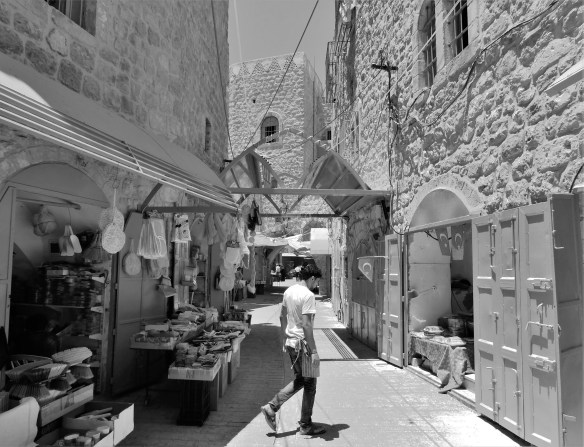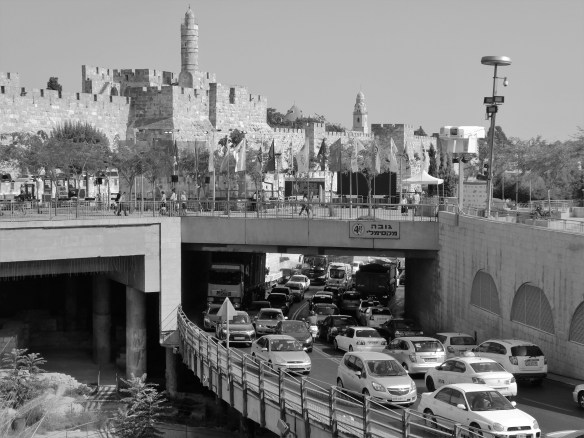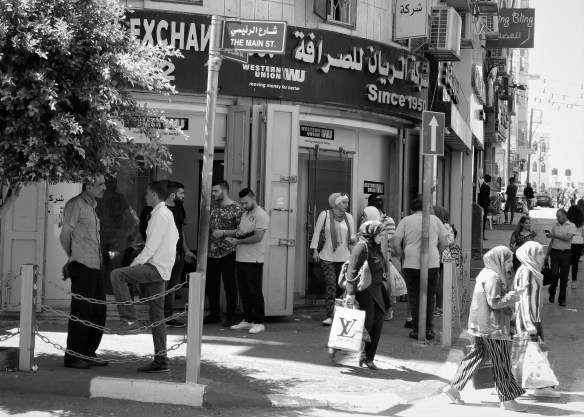Today, I went to visit Hebron, the largest city in the West Bank, and the Tomb of the Patriarchs, where Abraham and several generations of his family are thought to have lived and are now buried. Hebron is a divided city, under both Palestinian and Israeli control. It’s divided into areas H1 and H2. Area H1 is entirely Palestinian, contains 80 % of the population and is under Palestinian control. Area H2 is contains the Jews and the remainder of the Arabs and is under full Israeli control. The border between the two sectors runs right down the middle of the Tomb of the Patriarchs. It’s a weird situation and unique in the West Bank in that the Jewish settlers have settled right smack dab in the centre of the old town, quite literally on top of the Palestinians. In other parts of the West Bank, they build settlements next to and around the Palestinian towns but not actually in them. The people moving to other settlements in the West Bank are motivated mainly by economics. It’s cheap. You can get a big comfortable house for a fraction of the cost of Jerusalem and it’s an easy commute. The Jewish settlers in Hebron on the other hand, are a different breed. They are hardcore Zionists. As a result there is a lot of tension between them and the Palestinians. The settlers are under protection of the Israeli Defence Forces with apparently four soldiers to every settler.
To get to Hebron, you have the choice of taking an Arab bus or an Israeli bus. I opted for the Israeli bus simply because it’s easier. There’s free Wi-Fi at the bus station, the bus is direct, you don’t need to deal with checkpoints; you get waved through… And… the bus is bullet proof! When I got to the bus station though, the bullet proof bus wasn’t coming for another hour, so I thought I could save time by taking a different bus which stopped at Kiryat Arba, the Jewish settlement just on the edge of Hebron and then taking another bus from there. I don’t know what I was thinking… It was like getting off the train at somewhere like Woy Woy and expecting it to be a major transport hub. Imagine the smallest, quietest ‘burb you can think of, divide it by ten and populate it with grumpy Jewish people… Well, then you’ve got Kiryat Arba! The only busses passing through there were the same bullet proof ones coming from Jerusalem, so I still had to wait the hour.
While I was waiting I approached a man on the street to enquire exactly where I should wait for the bullet proof bus. It turns out he is a Jew from the north-east of India, somewhere close to the border of Bangladesh. I honestly didn’t know there was such a thing: North-east Indian Jews. You learn something new every day! … Anyway, I think he took pity on me and offered to drive me to the Tomb of the Patriarchs. We get in his car and drive off. We start he chatting… He tells me he is from north-east India and I tell him I’m from Australia. He starts laughing and says, “My gun is from Australia” and points to the gun on the dash. “That’s nice” I replied, smiling on the outside but quietly freaking out on the inside. “Ha ha, no, not really” he says… “I work in security for the Parliament” … “Oh, you jokester, you!” And then, we arrived at the Tomb of the Patriarchs. I thanked him, shook his hand and off I went to explore Hebron.
Arrival at the tomb on the Jewish side…
It was Muslim prayer time when I arrived, so the tomb was closed to tourists for about thirty minutes. While I was waiting, I went through the checkpoint to explore the old city of Hebron. For me, as an obvious non-Jew and non-Muslim, it wasn’t an issue passing in either direction through the checkpoint. You could see the Palestinian guys get a really hard time when they pass back. The Palestinian guy in front of me had to take off his shirt, shoes, belt, roll up his pants and even then they made him walk through the metal detector multiple times. When I walked through and the alarm sounded, they just asked me, “Do you have a knife or a gun?” Of course I replied “No” They took my word for it, waved me through and wished me a nice time in Hebron.
The old city of Hebron is very attractive and it is also a UNESCO World Heritage Site.

As you walk through the old city and you look up, you notice that the alley ways are caged in with wire and bars covered in rubbish. Above the bars and wires live the settlers who through the rubbish and stones onto the Palestinians below.
Beyond the old town is the modern town. It’s quite a bustling city. It seems that the dodgier the city, the cheaper the felafel. In Tel Aviv it’s 20 shekels, Jerusalem it’s 15, Bethlehem 5 and in Hebron it’s only 3!
Then it was time to enter the tomb from the Muslim side…
They wanted me to go in drag, as a sign of respect. Standing in front of Rebecca’s tomb…

Inside …
Time to go home, so it’s back on the bullet-proof bus bound for Jerusalem.
“I’m bullet proof, nothing to loose… Fire away, Fire away. Ricochet, you take your aim… Fire away, fire away. You shoot me down, but I won’t fall… I am titanium.”

















































































































































